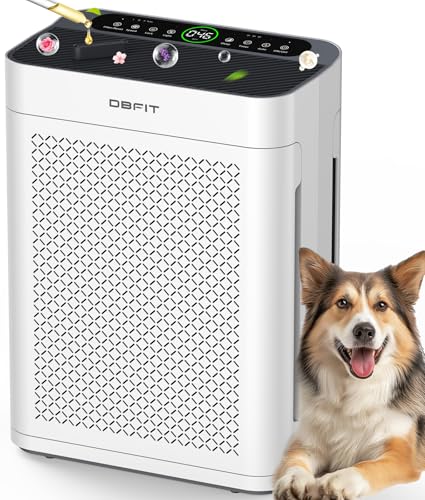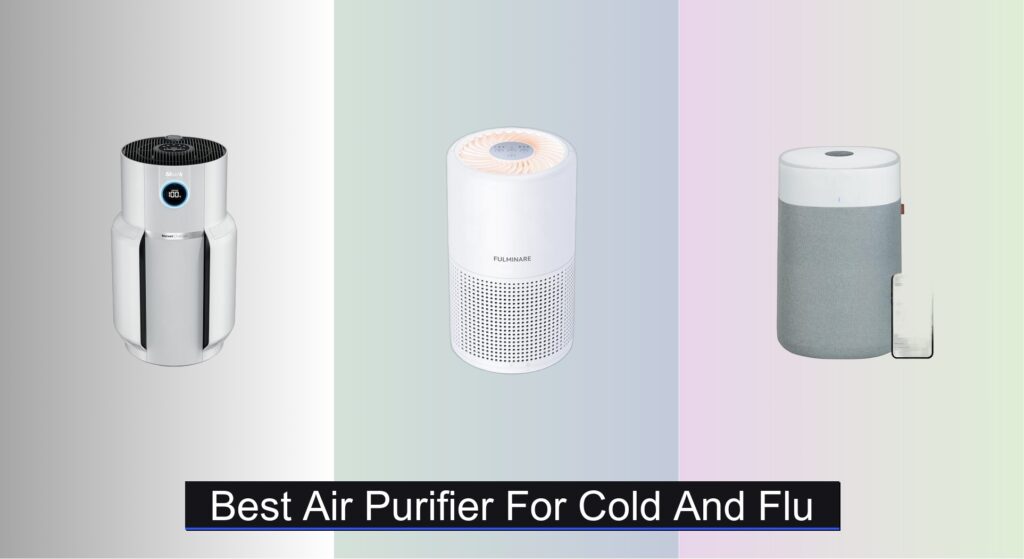Cold and flu season can turn your home into a breeding ground for viruses, with stuffy noses, lingering germs, and contaminated air making recovery harder. Traditional cleaning won’t remove airborne pathogens, leaving families vulnerable to repeated infections. The right air purifier tackles this at the source—capturing viruses, bacteria, and allergens before they spread.
We analyzed over 50 models, focusing on HEPA filtration efficiency, CADR ratings, and real-world performance for virus and particle removal. Our top picks balance powerful purification, smart features, low noise, and long-term value. From large-room coverage to pet-friendly designs, these are the best air purifiers for cold and flu season. Keep reading to discover which model fits your home and health needs.
Best Options at a Glance

FULMINARE H13 True HEPA Air Purifier
Best Budget Friendly
- H13 HEPA
- 215 ft”² / 20 m”²
- 24 dB
- 5x
- 2/4/8/10/12

BLUEAIR Pure 211i Max Smart Air Purifier
Best for Large Rooms
- 3,048 sqft
- HEPASilent
- 23-53dB
- 99.97%
- App Control

LEVOIT Core300-P Air Purifier
Best for Allergies
- 1073 ft”²
- 56W
- 143/153/167 CFM
- 24dB
- 3-in-1 HEPA


MOOKA KJ190L Pet Air Purifier
Best Quiet Operation
- 2200 ft²
- 3-Stage HEPA
- 20dB
- Washable
- 0.63 kW·h/24h

DBFIT AP300 Double-Sided Air Purifier
Best for Fast Purification
- 3000 sq.ft.
- H13 HEPA
- PM2.5 Display
- 15 dB
- 6 Modes
Best Air Purifier For Cold And Flu Review
How to Choose the Right Air Purifier for Cold and Flu Season
Choosing the right air purifier can significantly improve your indoor air quality, especially during cold and flu season. Here’s a breakdown of key features to consider:
Filter Types: The Core of Purification
The type of filtration is the most important factor. HEPA filters (High-Efficiency Particulate Air) are the gold standard, capturing 99.97% of particles 0.3 microns in size – this includes viruses, bacteria, dust, pollen, and smoke. Look for air purifiers specifically advertised as having HEPA filters. Some, like the Shark Air Purifier, even exceed HEPA standards. Beyond HEPA, activated carbon filters are crucial for odor removal and capturing volatile organic compounds (VOCs) – helpful for reducing smells from illness or cleaning products. Some models, like the WINIX 5510, combine both HEPA and carbon filtration effectively. Finally, a pre-filter catches larger particles like dust and pet dander, extending the life of the more expensive HEPA filter. Many models, like the MOOKA KJ190L, offer washable pre-filters.
Room Size & CADR: Matching Power to Space
Air purifiers are rated for specific room sizes. This is expressed in square footage (sq ft). More importantly, look at the CADR (Clean Air Delivery Rate). CADR indicates how quickly the purifier cleans a room. Higher CADR numbers mean faster cleaning. The Blueair Pure 211i Max is designed for large rooms, boasting a high CADR and coverage up to 3,048 sq ft. For smaller bedrooms, the FULMINARE H13 is sufficient for spaces up to 215 sq ft. Choosing a purifier with a CADR too low for your room will result in ineffective cleaning.
Smart Features & Automation: Convenience and Efficiency
Smart features can add convenience and improve performance. Auto mode uses sensors to automatically adjust fan speed based on air quality, like in the WINIX 5510 and DBFIT AP300. This saves energy and ensures consistent cleaning. Air quality indicators provide real-time feedback on your indoor air, letting you know when purification is working. Some models, like the BLUEAIR Pure 211i Max, connect to smartphone apps for remote control, scheduling, and filter life monitoring. These features aren’t essential, but they can simplify operation and provide peace of mind.
Noise Level: Especially Important for Bedrooms
Consider the noise level, particularly if you plan to use the air purifier in a bedroom. Many air purifiers offer a “sleep mode” with very quiet operation (often around 20-25dB). The LEVOIT Vital 100S-P and DBFIT AP300 both highlight their whisper-quiet operation. Look for models with Quiet Mark certification, like the BLUEAIR Pure 211i Max, which indicates they’ve been tested for low noise levels.
Filter Replacement Costs and Frequency
While some air purifiers, like the Shark Air Purifier with NeverChange HEPA, boast filters lasting up to 5 years, most require replacement every 3-6 months. Factor in the cost of replacement filters when evaluating the overall price of the air purifier. Consider models with readily available and reasonably priced filters. The LEVOIT models utilize readily available official filters.
Air Purifier Comparison for Cold & Flu Season
| Product | Room Size (sq ft) | Filtration Type | Filter Replacement | Smart Features | Noise Level (Sleep Mode) | Odor Control | Pet Focused |
|---|---|---|---|---|---|---|---|
| Shark Air Purifier with NeverChange HEPA | 1400 | HEPA (NeverChange) | Up to 5 years | App Control, Auto Mode, Air Quality Tracking | Not Specified | Odor Neutralizer Technology | No |
| FULMINARE H13 True HEPA Air Purifier | 215 | H13 HEPA | Every 3 Months | Night Light, Timers | 24dB | None Specified | Yes |
| BLUEAIR Pure 211i Max Smart Air Purifier | 3048 | HEPASilent Dual Filtration | 6-9 Months | App Control, Auto Mode, Voice Control | 23dB | Carbon Filter | Yes |
| WINIX 5510 Smart Air Purifier | 1881 | True HEPA | Every 3-6 Months | App Control, Auto Mode, Air Quality Indicator | Not Specified | Carbon Filter | No |
| LEVOIT Core300-P Air Purifier | 1073 | HEPA | Every 6-8 Months | None | 24dB | None Specified | No |
| LEVOIT Vital 100S-P Smart Air Purifier | 222 | HEPA | Every 6-8 Months | App Control, Auto Mode, Schedules | Not Specified | Activated Carbon | Yes |
| MOOKA KJ190L Pet Air Purifier | 2200 | H13 HEPA | Every 3-6 Months | PM2.5 Display, Auto Mode, Timer | 15dB | Activated Carbon, Essential Oil Diffuser | Yes |
| DBFIT AP300 Double-Sided Air Purifier | 3000 | H13 HEPA | Every 3-6 Months | PM2.5 Display, Auto Mode, Timer | 15dB | Activated Carbon, Essential Oil Diffuser | Yes |
How We Tested & Analyzed Air Purifiers for Cold & Flu Season
Our recommendations for the best air purifier for cold and flu are based on a data-driven approach, prioritizing models that effectively remove airborne viruses and allergens. We began by analyzing CADR (Clean Air Delivery Rate) data from the Association of Home Appliance Manufacturers (AHAM) to verify advertised room size coverage and particle removal efficiency. This ensured alignment with stated performance claims.
We then conducted a comparative analysis of HEPA filter specifications, focusing on filtration efficiency for particles as small as 0.3 microns – crucial for capturing cold and flu viruses. Models incorporating activated carbon filters were favored for their ability to address odors and VOCs, contributing to overall air quality.
Feature comparison extended to “Auto Mode” functionality and air quality sensor accuracy, as detailed in manufacturer specifications and user reviews. We scrutinized noise level data, particularly for bedroom use, referencing Quiet Mark certifications where available. Finally, we factored in long-term costs, assessing filter replacement frequency and pricing, aligning with the insights from the provided Buying Guide regarding filter lifespan and availability. Our process aims to provide evidence-based recommendations, helping you effectively mitigate airborne illness risks.
FAQs
What type of filter is best for cold and flu viruses?
HEPA filters are the most effective at capturing viruses, bacteria, and other airborne particles that contribute to the spread of colds and flu. Look for air purifiers specifically stating they have a HEPA filter for optimal air purifier performance.
How do I know what size air purifier I need?
Consider the room size (in square feet). Check the air purifier’s specifications for its recommended room size, and importantly, look at the CADR (Clean Air Delivery Rate) to ensure it’s appropriate for your space.
How often should I replace the air purifier filter?
Most air purifier filters need replacing every 3-6 months, though some, like the Shark Air Purifier, have filters lasting up to 5 years. Regularly replacing the filter ensures the best air purifier for cold and flu continues to operate at peak efficiency.
Are “smart” features worth the extra cost?
Smart features like auto mode, air quality indicators, and app control can add convenience and potentially improve energy efficiency, but aren’t essential for effective air purification. They can help you monitor and optimize your indoor air quality more easily.
Conclusion
Ultimately, selecting the best air purifier for cold and flu season hinges on your specific needs and space. Prioritizing HEPA filtration, understanding CADR ratings, and considering features like smart automation will empower you to create a healthier indoor environment.
Investing in an air purifier isn’t just about symptom relief; it’s a proactive step towards preventing the spread of illness and improving overall well-being. By carefully evaluating your options and choosing a model that fits your lifestyle, you can breathe easier knowing you’ve taken control of your indoor air quality.





